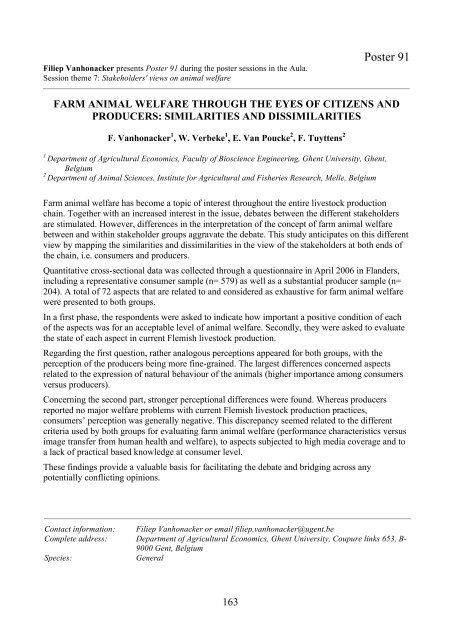Acknowledgements Book of abstracts - Publicaties - Vlaanderen.be
Acknowledgements Book of abstracts - Publicaties - Vlaanderen.be
Acknowledgements Book of abstracts - Publicaties - Vlaanderen.be
You also want an ePaper? Increase the reach of your titles
YUMPU automatically turns print PDFs into web optimized ePapers that Google loves.
Filiep Vanhonacker presents Poster 91 during the poster sessions in the Aula.<br />
Session theme 7: Stakeholders' views on animal welfare<br />
163<br />
Poster 91<br />
FARM ANIMAL WELFARE THROUGH THE EYES OF CITIZENS AND<br />
PRODUCERS: SIMILARITIES AND DISSIMILARITIES<br />
F. Vanhonacker 1 , W. Ver<strong>be</strong>ke 1 , E. Van Poucke 2 , F. Tuyttens 2<br />
1<br />
Department <strong>of</strong> Agricultural Economics, Faculty <strong>of</strong> Bioscience Engineering, Ghent University, Ghent,<br />
Belgium<br />
2<br />
Department <strong>of</strong> Animal Sciences, Institute for Agricultural and Fisheries Research, Melle, Belgium<br />
Farm animal welfare has <strong>be</strong>come a topic <strong>of</strong> interest throughout the entire livestock production<br />
chain. Together with an increased interest in the issue, debates <strong>be</strong>tween the different stakeholders<br />
are stimulated. However, differences in the interpretation <strong>of</strong> the concept <strong>of</strong> farm animal welfare<br />
<strong>be</strong>tween and within stakeholder groups aggravate the debate. This study anticipates on this different<br />
view by mapping the similarities and dissimilarities in the view <strong>of</strong> the stakeholders at both ends <strong>of</strong><br />
the chain, i.e. consumers and producers.<br />
Quantitative cross-sectional data was collected through a questionnaire in April 2006 in Flanders,<br />
including a representative consumer sample (n= 579) as well as a substantial producer sample (n=<br />
204). A total <strong>of</strong> 72 aspects that are related to and considered as exhaustive for farm animal welfare<br />
were presented to both groups.<br />
In a first phase, the respondents were asked to indicate how important a positive condition <strong>of</strong> each<br />
<strong>of</strong> the aspects was for an acceptable level <strong>of</strong> animal welfare. Secondly, they were asked to evaluate<br />
the state <strong>of</strong> each aspect in current Flemish livestock production.<br />
Regarding the first question, rather analogous perceptions appeared for both groups, with the<br />
perception <strong>of</strong> the producers <strong>be</strong>ing more fine-grained. The largest differences concerned aspects<br />
related to the expression <strong>of</strong> natural <strong>be</strong>haviour <strong>of</strong> the animals (higher importance among consumers<br />
versus producers).<br />
Concerning the second part, stronger perceptional differences were found. Whereas producers<br />
reported no major welfare problems with current Flemish livestock production practices,<br />
consumers’ perception was generally negative. This discrepancy seemed related to the different<br />
criteria used by both groups for evaluating farm animal welfare (performance characteristics versus<br />
image transfer from human health and welfare), to aspects subjected to high media coverage and to<br />
a lack <strong>of</strong> practical based knowledge at consumer level.<br />
These findings provide a valuable basis for facilitating the debate and bridging across any<br />
potentially conflicting opinions.<br />
Contact information: Filiep Vanhonacker or email filiep.vanhonacker@ugent.<strong>be</strong><br />
Complete address: Department <strong>of</strong> Agricultural Economics, Ghent University, Coupure links 653, B-<br />
9000 Gent, Belgium<br />
Species: General
















